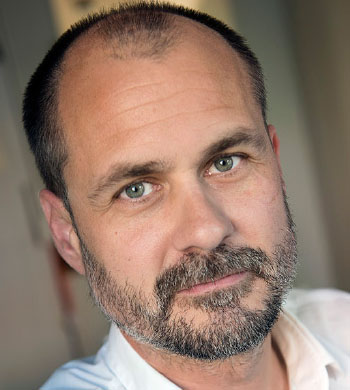Insulin
The pancreas is a gland in the abdomen with two major functions: digestion and glucose regulation. The architecture of the human pancreas is not fully understood, but it´s more about minor details missing, or where there is different findings. The islet of Langerhans comprise to ~2% of the pancreatic mass, and the diameter of one islet is about 100 μm, or 0.1 mm (1). The human pancreas has about 1-2 million islets (2), and the beta cells has a diameter of about 0.01 mm (3).
Human islets consist of circa 30% glucagon-producing alpha cells (glucagon increase glucose in different ways, 4), circa 60% insulin producing beta cells, with the remainder circa 10% made up of delta cells (somatostatin-producing, somatostatins primary function is to prevent the production of other hormones and also stop the unnatural rapid reproduction of cells - such as those that may occur in tumours. The hormone also acts as a neurotransmitter and has a role in the gastrointestinal tract, 5), PP cells (pancreatic polypeptide-producing, 6), and ghrelin-cells (ghrelin "the hunger hormone", 7, 8). A peptide hormone called amylin is cosecreted with insulin by the beta cells, and the function is not fully understood. We do know it inhibits glucagon secretion, delays gastric emptying, and acts as a satiety agent. After beta cell death, naturally no amylin is produced, 9.
Insulin is one of the body's most potent hormones (proteins). Insulin is latin for island, "insula" (10). Insulin was actually named before Frederick Banting and colleagues isolated it 1921, for which they achieved Nobel Prize in medicine in 1923 (11). The evidence of some kind of "a pancreatic substance" missing in some people with diabetes was strong before 1921, a substance having a substantial role in metabolism and glucose regulation. The efforts from researchers was rather to isolate this substance, and Banting and colleagues won the race. Their work is still seen as one of the major discoveries in the history of medicine, a discovery that until today have saved millions of lives globally. No one can live without insulin. A healthy individual have constantly about 200-300U (units) insulin in the beta cells, 200U is 2 ml (compare with a 1 ml measuring spoon). The beta cells release 30-50U per day, of course with an individual difference depending on many things (easy-to-read 12). Insulin have a number of functions, on top of what some are aware of, the "key" for opening cells for glucose to be used/burned as energy. These are the main tasks, please note that insulin is not alone responsible for all these processes but play an important role:
- Insulin works as a key and opens the cells so glucose can be used/burned as energy.
- The body is amazing to produce glucose from other macronutrients if needed. Mostly from amino acids and particular alanine. This process is called gluconeogenesis and is inhibited by insulin (12, 13, 14, 15).
- The glucose that the body doesn´t immediately need for energy is stored in the liver and the muscles as glycogen, to be used later when needed, and as fat. The process to store glucose in the liver and muscles as glycogen is called glycogenesis and for this insulin is needed (15).
- Insulin inhibit glycogenolysis, break down of stored glycogen to glucose for immediate use as energy (13, 15).
- Triglycerides from food is the major dietary fat, and what we normally talk about when using the term fat. Lipolysis is a process when triglycerides is broken down from food as well as from stored fat. Insulin inhibit the lipolysis (13).
- Insulin stimulate protein synthesis in cells, where new proteins are produced continously and balanced by the loss of cellular proteins (14).
- In fact, the description of insulins role as a "door opener" for glucose to the cells is correct, but simplified. The majority of functions are at the liver, one study suggest that so much as ~80% might be (16, 17).
References:
- https://www.ncbi.nlm.nih.gov/pmc/articles/PMC5867580/
- https://www.biorxiv.org/content/10.1101/480509v1.full
- https://www.frontiersin.org/articles/10.3389/fcell.2017.00055/full
- https://www.yourhormones.info/hormones/glucagon/
- https://www.hormone.org/your-health-and-hormones/glands-and-hormones-a-to-z/hormones/somatostatin
- https://mesh.kib.ki.se/term/D010191/pancreatic-polypeptide
- https://www.yourhormones.info/hormones/ghrelin/
- https://jme.bioscientifica.com/view/journals/jme/52/1/R35.xml
- https://diabetes.diabetesjournals.org/content/53/suppl_3/S233
- http://www.yourhormones.info/hormones/insulin/
- https://www.nobelprize.org/nobel_prizes/medicine/laureates/1923/banting-bio.html
- https://www.britannica.com/science/insulin
- https://nyaspubs.onlinelibrary.wiley.com/doi/pdf/10.1111/nyas.13435
- https://themedicalbiochemistrypage.org/insulin.php
- https://www.nature.com/articles/emm2015122
- "Pulsatile Insulin Secretion Dictates Systemic Insulin Delivery by Regulating Hepatic Insulin Extraction In Humans": https://doi.org/10.2337/diabetes.54.6.1649
- "The cell biology of systemic insulin function", https://doi.org/1083/jcb.201802095

















